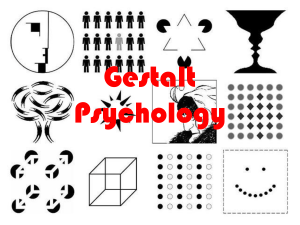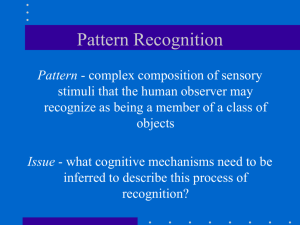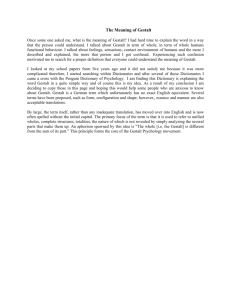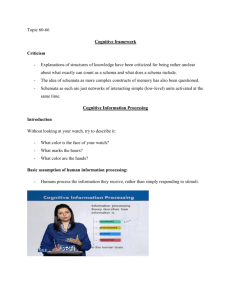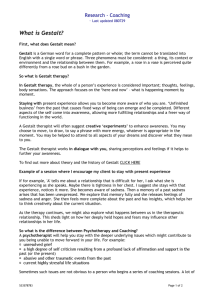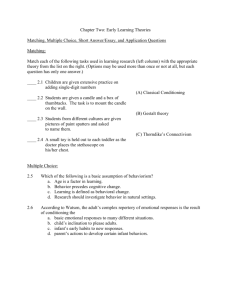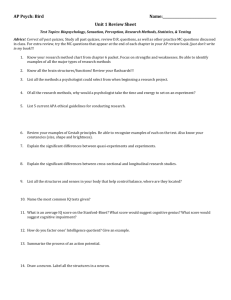Sensation and Perception
advertisement
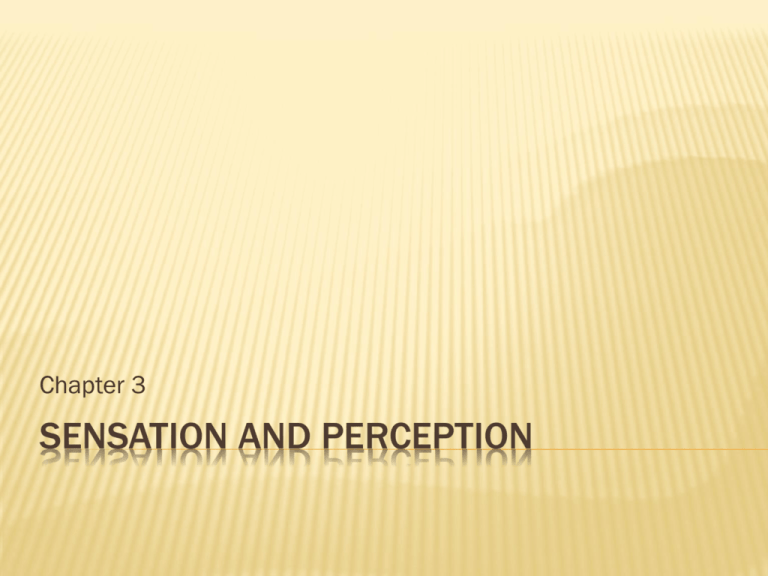
Chapter 3 SENSATION AND PERCEPTION WHAT IS SENSATION? Sensation is the process in which we receive, transform, and process stimuli from the outside world to create sensory experiences of vision, touch, hearing, taste, smell and so on. There are actually 7 body senses, not just the 5 we normally think of. SENSATION Sensory receptors- Specialized cells that detect sensory stimuli and convert them into neural impulses, which the brain uses to create the sensations of our senses. Absolute Threshold- The smallest amount of a given stimulus a person can sense. ABSOLUTE THRESHOLDS Sense Stimulus Receptors Threshold Vision Light energy Rods and cones in the eye Flame from a single candle 30 miles away Hearing Sound waves Hair cells in the inner ear Ticking of a watch about 20 ft. away Taste Chemical substances that contact the tongue Taste buds on the tongue One teaspoon of sugar dissolved in 2 gallons of water Smell Chemical substances that enter the nose Receptor cells in the One drop of upper nostrils perfume dispensed in a small house Touch Movement of, or pressure on, the skin Nerve endings in the skin The wing of a bee falling on the cheek from about 1 cm. ERNST WEBER 1795-1878 Came up with the idea of difference threshold or just-noticeable difference. Difference Threshold- The minimal difference between 2 stimuli that people can reliably detect. WEBER’S LAW The amount you must change a stimulus to detect a difference is given by a constant fraction or proportion. Ex. Weber’s constant for noticing a difference in weight is 1/50 or 2% If you were lifting a 50 lb. weight, you would probably not notice a difference unless the weight were increased or decreased by 2% (1 lb.). WEBER’S LAW If you were lifting a 50 lb. weight, you would probably not notice a difference unless the weight were increased or decreased by 2% (1 lb.). But, if you were lifting a 200 lb. weight, the weight would have to be increased or reduced by 4 lbs. (2%) to notice a difference. SIGNAL DETECTION THEORY Detection of a stimulus depends on these factors The intensity of the stimulus The level of background stimulus Biological and psychological characteristics of the perceiver. SIGNAL DETECTION THEORY Physical condition can play a role in Signal Detection Sense of smell is more dull if your nose is stuffed or if you have a cold. Alertness levels affect signal detection Motivation: Walking down a dark alley, staying home alone (notice sounds). Hunger: Aromas or TV commercials when you haven’t eaten in a while SENSORY ADAPTATION The process by which sensory receptors adapt to constant stimuli by becoming less sensitive to them. Cold swimming water Wristwatch, ring Music Odors ( i.e., men’s locker room) PERCEPTION Perception- The process by which the brain interprets sensory information, turning it into meaningful representations of the external world. Through perception, our brain attempts to make sense of the mass of sensory stimuli that impinge on our sensory organs. ATTENTION: DID YOU NOTICE THAT? Attention is the first step in perception. Through selective attention you limit your attention to certain stimuli while filtering out other stimuli. Selective attention prevents you from being flooded with extraneous information. ATTENTION: DID YOU NOTICE THAT? We pay more attention to stimuli that are meaningful or emotionally significant. Motivational states, such as hunger or thirst, play important roles in attention. When we are hungry, we are more likely than when we’ve just eaten to pay attention to odors wafting out of a restaurant. ATTENTION: DID YOU NOTICE THAT? Repeated exposure may increase attention to particular stimuli. On the other hand, exposure to a constant stimulus can lead us to become habituated, or accustomed, to a stimulus. Ex. The humming sound of an air conditioner MODES OF VISUAL PROCESSING: BOTTOM-UP VS. TOP-DOWN Bottom-up Processing- The brain assembles specific features of shapes, such as angles and lines, to form patterns that we can compare with stored images we have seen before. Bottom-up processing may also be used to combine the individual elements of letters and words into recognizable patterns. MODES OF VISUAL PROCESSING: BOTTOM-UP VS. TOP-DOWN Top-Down Processing- perceiving patterns as meaningful wholes- such as recognizing faces of people we knowwithout needing to piece together their components. Top-down is based on acquired experience and knowledge with patterns, but it is not perfect. GESTALT LAWS OF GROUPING People tend to group bits and pieces of sensory information into unitary forms or wholes. Gestalt psychologists described several principles of grouping, including proximity, similarity, continuity, closure, and connectedness. GESTALT LAWS OF GROUPING Proximity- the principle that objects that are near each other will be perceived as belonging to a common set. GESTALT LAWS OF GROUPING Similarity- The principle that objects that are similar will be perceived as belonging to the same group. GESTALT LAWS OF GROUPING Continuity- The principle that a series of stimuli will be perceived as representing a unified form. GESTALT LAWS OF GROUPING Closure- The perceptual principle that people tend to piece together disconnected bits of information to perceive whole forms. GESTALT LAWS OF GROUPING Connectedness- The principle that objects positioned together or moving together will be perceived as belonging to the same group. GESTALT USE IN SPORTS LOGOS GESTALT USE IN SPORTS LOGOS GESTALT USE IN SPORTS LOGOS GESTALT USE IN SPORTS LOGOS GESTALT USE IN SPORTS LOGOS
